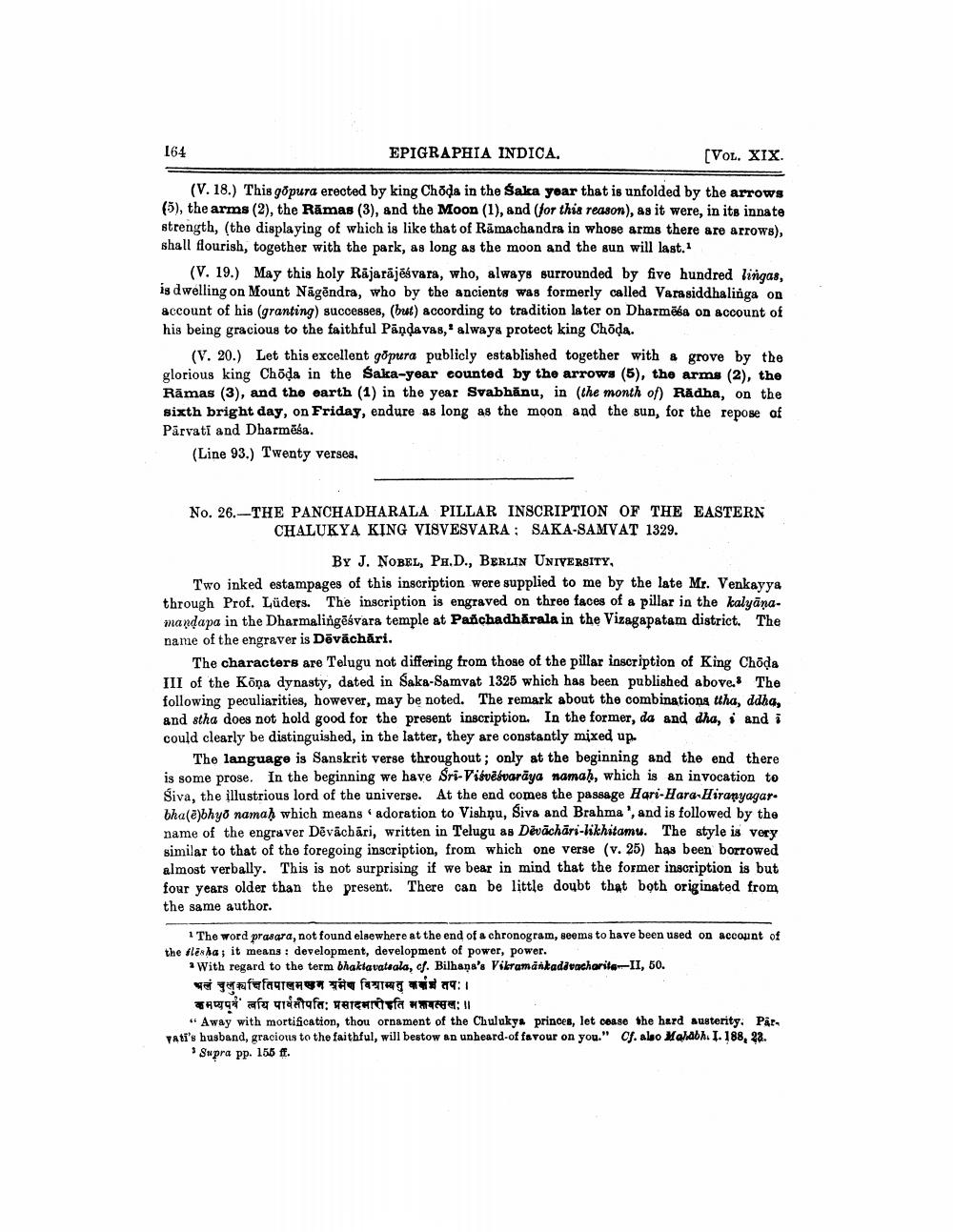________________
164 EPIGRAPHIA INDICA.
(VOL. XIX =
(V. 18.) This gopura erected by king Choda in the Saka year that is unfolded by the arrows (5), the arms (2), the Rāmas (3), and the Moon (1), and for this reason), as it were, in its innate strength, (the displaying of which is like that of Ramachandra in whose arms there are arrows), shall flourish, together with the park, as long as the moon and the sun will last.
(V. 19.) May this holy Rajarajesvara, who, always surrounded by five hundred lingas, is dwelling on Mount Nāgēndra, who by the ancients was formerly called Varasiddhalinga on account of his (granting) successes, (but) according to tradition later on Dharmēba on account of his being gracious to the faithful Pāņda vas,' always protect king Choda.
(V. 20.) Let this excellent gopura publicly established together with a grove by the glorious king Choda in the Saka-year counted by the arrows (5), the arms (2), the Rāmas (3), and the earth (1) in the year Swabhānu, in the month of) Rādha, on the sixth bright day, on Friday, endure as long as the moon and the sun, for the repose of Pārvati and Dharmēša.
(Line 93.) Twenty verses.
No. 26. -THE PANCHADHARALA PILLAR INSCRIPTION OF THE EASTERN
CHALUKYA KING VISVESVARA; SAKA-SAMVAT 1329.
BY J. NOBEL, PH.D., BERLIN UNIVERSITY, Two inked estampages of this inscription were supplied to me by the late Mr. Venkayya through Prof. Lüders. The inscription is engraved on three faces of a pillar in the kalyāna. mandapa in the Dharmalingēsvara temple at Panchadhārala in the Vizagapatam district. The name of the engraver is Dēvächāri.
The characters are Telugu not differing from those of the pillar inscription of King Chöda III of the Köna dynasty, dated in Saka-Samvat 1325 which has been published above. The following peculiarities, however, may be noted. The remark about the combinations ttha, ddha, and stha does not hold good for the present inscription. In the former, da and dha, i and i could clearly be distinguished, in the latter, they are constantly mixed up.
The language is Sanskrit verse throughout; only at the beginning and the end there is some prose. In the beginning we have Sri-Visvēsvarāya namah, which is an invocation to Siva, the illustrious lord of the universe. At the end comes the passage Hari-Hara Hiranyagar. bha(a)bhyo namah which means adoration to Vishnu, Siva and Brahma', and is followed by the name of the engraver Dēvācbāri, written in Telugu as Dévāchāri-likhitamu. The style is very similar to that of the foregoing inscription, from which one verse (v. 25) has been borrowed almost verbally. This is not surprising if we bear in mind that the former inscription is but four years older than the present. There can be little doubt that both originated from the same author.
1 The word prasara, not found elsewhere at the end of a chronogram, seems to have been used on account of the flesha ; it means : development, development of power, power.
* With regard to the term bhaklavataala, of. Bilhana's Vikramantaddvacharita-II, 50. भलं चुलक्यचितिपालमखन अमेश विश्राम्य तु कर्क तपः । कमप्यपूर्व त्वयि पार्वतीपतिः प्रसादमारीइति मन्तवत्सलः ॥
"Away with mortification, thou ornament of the Chulukys princes, let cease the herd austerity, PårTati's husband, gracious to the faithful, will bestow an unheard of favour on you." Cf. alao Malabh. I. 188, 28.
$ Supra pp. 155 ff.




